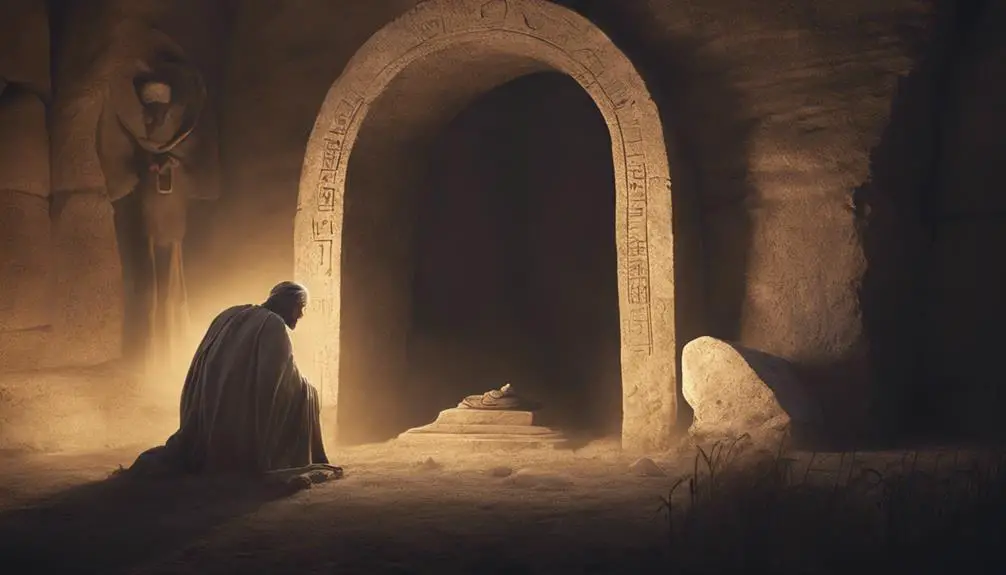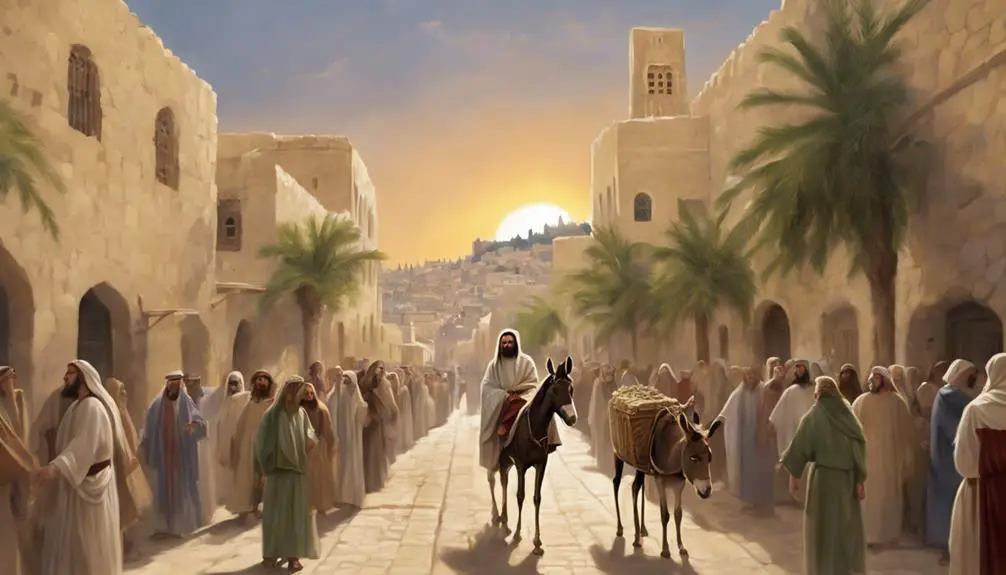Uncover Bethany's biblical secrets where miracles unfold and destinies intertwine, leaving a lasting impact on faith and the human spirit.

What Happened in Bethany in the Bible
Bethany serves as a crossroads in the biblical narrative, where miracles and mortal lives intertwine. You'll find it's not just a backdrop for mundane events; rather, it's where Jesus forges deep, personal connections, exemplified in his interactions with Mary, Martha, and Lazarus.
From witnessing Lazarus's astonishing return from the grave to being anointed in a manner that foreshadows his impending sacrifice, Bethany encapsulates pivotal moments that invite you to explore deeper. Each story, like threads in a tapestry, weaves a complex picture of faith, love, and destiny, compelling you to uncover how these events influence the larger narrative.
Key Takeaways
- Bethany was the setting for significant events, including the raising of Lazarus, showcasing Jesus' power over death.
- Jesus' visit to Mary and Martha's home highlighted differing approaches to discipleship and hospitality.
- The anointing at Bethany involved a prophetic act of devotion, emphasizing Jesus' impending death and honoring him.
- Bethany served as a backdrop for Jesus' triumphal entry, symbolizing his kingship and fulfilling biblical prophecy.
The Home of Mary and Martha

Bethany served as the residence of Mary and Martha, two pivotal figures who demonstrate the intimate hospitality offered to Jesus during his earthly ministry. Their home becomes a focal point for understanding the cultural and religious significance of hospitality customs in ancient Judea. The narratives surrounding these two sisters, found in the biblical texts, provide a nuanced exploration of sisterly dynamics within the context of hosting a revered guest.
Analyzing the interactions between Mary, Martha, and Jesus, you uncover layers of social and theological implications. Martha's role, often associated with the preparation and serving of the meal, reflects the active component of hospitality, adhering to the expectations placed upon women in her society. In contrast, Mary's choice to sit and listen to Jesus, prioritizing spiritual engagement over traditional hospitality duties, challenges societal norms and suggests a reevaluation of priorities within the domain of religious practice.
The contrast between Mary and Martha's approaches to hospitality not only highlights the diversity of roles within the household but also invites a broader reflection on the balance between service and spiritual mindfulness. This duality within the sisterly dynamics enriches the biblical narrative, offering profound insights into the hospitality customs and social expectations of their time.
The Raising of Lazarus

One of the most profound events recorded in the New Testament, the raising of Lazarus illustrates the depth of Jesus' power and his emotional connection to those he loved. Upon hearing of Lazarus' sickness, Jesus delayed his visit, allowing for Lazarus' death to serve as a foundation for a greater demonstration of divine power. The narrative reaches its climax with Jesus' arrival at the tomb, where he commands Lazarus to come forth, showcasing an undeniable miracle.
To delve deeper into this pivotal event, consider the following aspects:
- *The significance of Jesus' deliberate delay in visiting Lazarus.*
- *The profound emotional response of Jesus upon seeing the mourning.*
- *The skepticism and astonishment of onlookers at the tomb visitation.*
- *The symbolic representation of Jesus as the resurrection and the life.*
- *The implications of this miracle for Jesus' ministry and the growing tension with religious authorities.*
This event not only underscores Jesus' miraculous abilities but also his profound empathy and connection to humanity. The raising of Lazarus serves as a testament to the belief in resurrection, reinforcing Jesus' role as a figure of salvation and eternal life.
Jesus' Triumphal Entry

Following the profound demonstration of power at Lazarus' tomb, Jesus' next significant act, his triumphal entry into Jerusalem, marked a pivotal moment in his ministry, reflecting both fulfillment of prophecy and the escalation of tensions with religious leaders. This event, often celebrated as Palm Sunday, saw Jesus entering Jerusalem on a donkey, an act symbolizing peace and fulfilling the prophecy from Zechariah 9:9. The choice of a donkey, as opposed to a warhorse, emphasized Jesus' role as a bringer of peace, rather than a military leader.
The crowd's reactions were a mix of jubilation and profound symbolism. They spread palm branches on the road before Jesus, a gesture of honor and recognition of victory. The palm branches, historically symbols of triumph and victory, here signified the acknowledgment by the people of Jesus' kingship. Their cries of 'Hosanna!'—a plea for salvation—echoed the deep yearning for a messianic deliverer.
However, this public display of support for Jesus as a messianic figure also heightened the tensions with the religious authorities. They perceived Jesus' popularity and the crowd's reactions as both a theological and political threat, setting the stage for the events that would unfold during the Passion Week.
The Anointing at Bethany

In the days leading up to Jesus' crucifixion, a significant and poignant event took place: his anointing by a woman in the village of Bethany. This event, deeply symbolic and rich in cultural customs, highlights several key aspects of the society and religious practices of the time.
- Perfume significance: The use of a costly perfume, often saved for significant events, underscores the importance of this act. It symbolizes honor, respect, and devotion, indicating the woman's deep reverence for Jesus.
- Cultural customs: Anointing was a customary practice for honoring guests, preparing bodies for burial, and in religious ceremonies, reflecting the multifaceted significance of this act.
- Social implications: The act broke social norms, as it was performed by a woman who took on a role reserved for men or family members, demonstrating Jesus' radical acceptance of societal outcasts.
- Prophetic significance: The anointing foreshadowed Jesus' death and burial, serving as a prophetic act that pointed to his impending crucifixion and the fulfillment of his mission.
- Response from disciples: The disciples' reaction, particularly Judas' objection to the perceived waste of resources, highlights the tension between earthly values and the spiritual significance of Jesus' mission.
This event in Bethany encapsulates key themes of sacrifice, honor, and prophecy, deeply rooted in the cultural and religious contexts of the time.
The Ascension of Jesus

The Ascension of Jesus marks a pivotal moment in Christian theology, symbolizing his return to the Divine after completing his earthly mission. This event isn't merely a historical footnote but a cornerstone of faith that bridges Jesus' earthly ministry with his eternal reign. The narrative of Jesus' heavenly departure unfolds in the presence of Apostolic witnesses, ensuring its significance is firmly anchored in the collective memory of early Christian communities. These witnesses, chosen by Jesus, serve a dual role: they're the last to see him in his physical form and the first to testify to his continued lordship from heaven.
Analyzing the Ascension, one must consider its theological implications. It confirms Jesus' divinity, asserting that his place is rightfully at the right hand of God. This act completes the cycle of redemption that began with the Incarnation, where the Divine entered the human condition. Furthermore, the presence of Apostolic witnesses underscores the credibility of the event. Their firsthand accounts provide a foundation upon which the early church built its teachings about Jesus' nature and the promise of his return. Thus, the Ascension isn't only a moment of heavenly departure but a testament to the fulfillment of Jesus' earthly mission, witnessed by those he entrusted with the gospel.
Frequently Asked Questions
How Did the Cultural and Historical Context of Bethany Influence the Events Described in the Bible?
To understand how Bethany's cultural and historical context influenced biblical events, it's crucial to examine its economic significance and population demographics.
The town's economic activities and diverse population shaped its social and cultural dynamics, impacting the narratives you'll find in the Bible.
This analysis reveals that the economic and demographic characteristics of Bethany played a pivotal role in how it's portrayed and the events that are said to have occurred there.
Are There Any Archaeological Findings in Bethany That Correlate With the Biblical Narratives?
Yes, modern excavations in Bethany have revealed findings that correlate with biblical narratives. These archaeological discoveries provide tangible evidence supporting events described in the scriptures.
Additionally, the impact of tourism, driven by these findings, has both preserved and altered the archaeological landscape. You're witnessing how historical validation intersects with contemporary economic and cultural influences, reshaping our understanding and interaction with ancient sites.
This blend of archaeology and tourism offers a unique lens to examine biblical history.
How Has the Portrayal of Bethany and Its Biblical Events Evolved in Art and Literature Throughout History?
You've seen how artistic interpretations and literary adaptations have evolved to reflect Bethany's biblical events.
Initially, these depictions stuck closely to scriptural accounts, focusing on literal translations of the text.
Over time, artists and writers began to infuse their works with personal, cultural, and historical contexts, enriching the narratives.
This evolution showcases how interpretations of Bethany have become more nuanced, demonstrating a deepening engagement with the biblical stories.
What Are the Theological Implications of Jesus Choosing Bethany for Significant Events, Such as the Ascension?
By selecting Bethany for significant events like the Ascension, Jesus underscored its divine selection, hinting at the spiritual proximity between heaven and earth. This choice wasn't arbitrary but laden with theological implications, suggesting a deliberate connection to this locale's historical and spiritual significance.
It invites you to ponder the symbolic meanings behind these events, encouraging a deeper exploration of the relationship between the physical and the divine realms.
How Do Different Christian Denominations Interpret the Significance of Bethany in the Life and Ministry of Jesus?
You'll find that different Christian denominations view Bethany's role in Jesus' life and ministry through varied lenses, emphasizing denominational unity and worship practices.
Catholics might see it as a pilgrimage site, enhancing communal worship, while Protestants could focus on personal faith milestones that occurred there.
Orthodox Christians might interpret Bethany's events as pivotal for liturgical traditions.
Despite these differences, all see Bethany as crucial in understanding Jesus' mission and message.
Conclusion
In conclusion, Bethany serves as a focal point for significant biblical narratives, illustrating the profound interactions between Jesus and his followers. From the intimate setting of Mary and Martha's home to the miraculous raising of Lazarus, each event underscores themes of faith, devotion, and resurrection.
The triumphal entry and the poignant anointing at Bethany further highlight Jesus' kingship and the preparation for his crucifixion. Ultimately, Bethany's narratives contribute to understanding Jesus' ministry and the essence of Christian belief.



Sign up